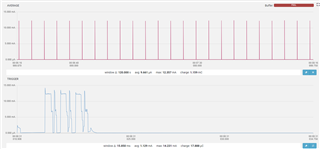Hello, we have run the power profiler on two different example projects, and want to understand the difference between the two.
When we run the blinky project
nRF5_SDK_16.0.0\examples\ble_peripheral\ble_app_blinky
And we slow down the advertising interval to about 5 seconds, we see the power draw drop to about zero in between advertising transmissions.
Later we started using the usart example (because we need uartcommunication, at least when connected).
\nRF5SDK160098a08e2\examples\ble_peripheral\ble_app_uart\pca10040\s112\arm5_no_packs
And we again slow down the advertising interval to about 5 seconds, except in this case we see the power draw drop only fractionally between advertising transmissions, significant power draw in between the advertising spikes.
Is this because of the uart? Does the uart being active prevent it from idling the same way as the blinky example?
If so, can we enable the uart only when connected, and allow it to drop to near zero when unconnected and advertising?
Just wanted to know what to expect before we trial and error a million different things -- OR if the above is not what you guys would expect and we may have a different issue of some sort.
Thanks!



